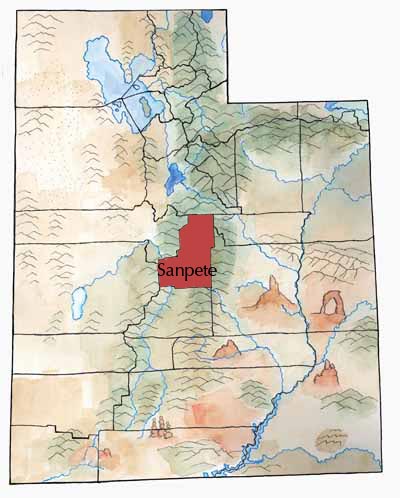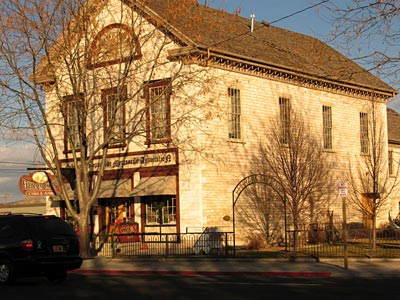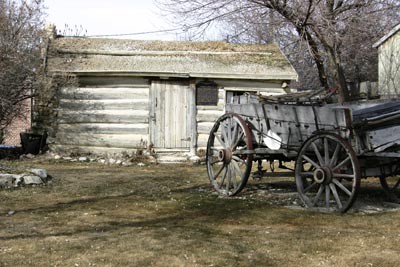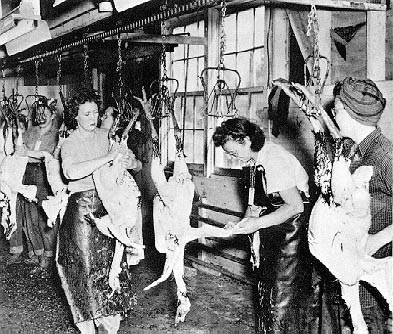Quick facts

Sanpete County straddles the Colorado Plateau and the Great Basin. On the east, creeks on the eastern slopes of the high Wasatch Plateau drain into the Colorado River system.
The streams in Sanpete Valley itself flow south to the Sevier River, which dead-ends in the Great Basin at Sevier “Lake.”
This beautiful green valley bordered by mountains and hills attracted many people over the centuries.
First Peoples
Sanpete’s earliest inhabitants include Fremont farmers. Archaeologists have discovered mounds which Fremont people left behind. As they dug they discovered small stone and mud-walled structures and pottery, points, and metates.
However, Sanpete has not been systematically studied like its neighbors south and east.
The Utes came after the Fremont people. The San Pitch Utes gathered and hunted in local marshes and canyons.
Other Utes acquired horses from the Spanish. These, often led by Ute chief Wakara, captured and sold San Pitch Indians into slavery. They also adopted parts of the Plains Indians culture, and they rode throughout the West. Some of these had a winter base camp in Sanpete.
Settlers

Wakara invited the Mormons to settle in Sanpete. Perhaps he thought they would help his people gain more resources or be good trading partners.
So the first Mormon settlers arrived in fall 1849. They chose the Manti site because of a nearby warm spring, the large limestone quarries where they could cut stone for buildings, and the fine farming and grazing lands nearby.
A few years later, Wakara was fighting the settlers in the Walker War of 1853-54. During this time, the settlers abandoned their new homes, or built forts for protection.
Sanpete was also hit hard by the Black Hawk War of 1865-68, which brought a more serious and prolonged period of guerrilla raids.
The larger towns were established during the first decade of settlement. Scandinavian immigrants soon made up a lot of the population, and elements of their culture and humor remain today.

A Presbyterian missionary established the Wasatch Academy in the 1870s; today it still thrives as a college prep school.
The towns peaked in population about 1900-1910 and declined until the 1970s.
Sanpete’s location at Utah’s geographical heart masks its isolation. Much interstate and recreational traffic bypass it. None of the small, scattered towns has developed as a center of economic development.
Economy
Since settlement, Sanpete’s economy has been agriculturally based. In its first few decades it served as Utah’s granary.
Cattle have always been important, but currently only a few large dairies survive. New beef breeds from Switzerland and France have joined the traditional Hereford and Angus to produce lower-fat, faster-growing animals.
Sheep dominated the local economy from the 1880s through the 1920s, and Sanpete played a prominent part in world markets for a time.

Turkeys, grown casually as a farmyard fowl, became a cooperative, integrated industry in response to the 1930s depression. Today they rule the roost in Sanpete, which ranks among the top ten turkey-producing counties in the country.
Snow College, a two-year institution with the main campus in Ephraim (and a second campus in Richfield, Sevier County), plays an important role in the local economy.
Sanpete County has worked on developing heritage tourism to complement its rural nature. It collaborated with other counties to gain a federal designation as the National Mormon Pioneer Heritage Area.
Did You Know?
| In the spring of 1850, the first settlers to Manti learned they had been living near a rattlesnake den. They killed 300 snakes the first day. |
| The county was a gathering place for Scandinavian immigrants: Danes, Swedes, and a few Norwegians. |
| Jewish settlers tried to establish a farming community at Clarion, 3 miles west of Gunnison, in 1911. It only lasted until 1917. |
| In the 1940s, Fountain Green had so many sheep it was called Wool City of the West. |
| Wasatch Academy, opened in 1875, is a boarding school that now has students from around the world. |
Fast Facts
Area: 1,597 Square Miles
County Seat: Manti
Where it Got its Name: A corruption of the name of a local Native American tribe called San Pitch.
Main Cities and Towns: Ephraim, Mount Pleasant, Manti, Gunnison
Keep Exploring!
Return to the County’s home page here.
Return to the I Love Utah History home page here.